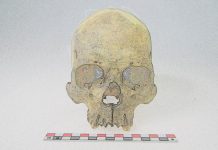
Human evolution has always been a fascinating puzzle, especially how we came to walk on two legs. Our ape cousins use a variety of movements, from swinging through trees to walking on all fours.
But until now, we’ve been unsure about how our ancestors shifted from using four limbs to just two.
A groundbreaking study, focusing on the 6-million-year-old fossil ape Lufengpithecus, is shedding new light on this mystery.
Researchers have found crucial clues hidden not in the bones we typically associate with walking, but in an unexpected place: the inner ear.
Yinan Zhang, a doctoral student at the Institute of Vertebrate Paleontology and Paleoanthropology of the Chinese Academy of Sciences, and the paper’s lead author, explains the significance.
“The semicircular canals in our inner ear, sitting between the brain and the external ear, play a crucial role in balance and movement. Most people don’t realize how important they are for locomotion.
By using advanced CT-scanning, we could look inside fossil skulls to examine these canals and understand how extinct mammals, including apes and humans, moved.”
Terry Harrison, a New York University anthropologist and co-author of the paper, outlines a three-step evolution of human bipedalism. Initially, early apes moved through trees in a way similar to today’s gibbons in Asia.
The last common ancestor of apes and humans, like Lufengpithecus, used a mix of climbing, hanging, tree-walking, and ground-walking. It’s from this versatile movement style that human bipedalism evolved.
Most previous studies focused on limb, shoulder, pelvis, and spine bones to understand how apes and humans move.
However, the variety of movements in living apes and incomplete fossil records made it hard to trace the origins of our two-legged walk.
The discovery of Lufengpithecus skulls in China’s Yunnan Province in the 1980s opened new doors for research.
But the skulls were heavily compressed and distorted, making it hard to study the inner ear area. Previous researchers even thought the delicate semicircular canals hadn’t been preserved.
To overcome this, Zhang, Ni, Harrison, and colleagues from the Yunnan Institute of Cultural Relics and Archaeology used 3D scanning technologies.
They created virtual reconstructions of the inner ear’s bony canals, then compared these scans with those from other living and fossil apes and humans across Asia, Europe, and Africa.
Their analysis revealed that early apes had a locomotor style that paved the way for human bipedalism.
Professor Xijun Ni, who led the project at IVPP, highlights the inner ear as a unique record of ape locomotion evolution, providing valuable insights beyond what we can learn from the skeleton.
Ni points out that most fossil apes and their ancestors show a locomotion mode between gibbons and African apes. The human lineage then branched off from the great apes, leading to bipedal species like Australopithecus in Africa.
The team also studied the evolution rate of the bony labyrinth in the ear, proposing that climate changes might have driven the diverse locomotion of apes and humans.
Harrison notes that cooler global temperatures around 3.2 million years ago, linked to the build-up of ice sheets, coincide with a spike in the rate of change in the bony labyrinth. This suggests a rapid evolution in how apes and humans moved.
In conclusion, this study not only provides a fresh perspective on human bipedalism’s origins but also highlights the intricate connections between our environment and evolutionary paths.
As we continue to uncover these links, we gain a deeper understanding of our journey as a species.
Source: New York University



